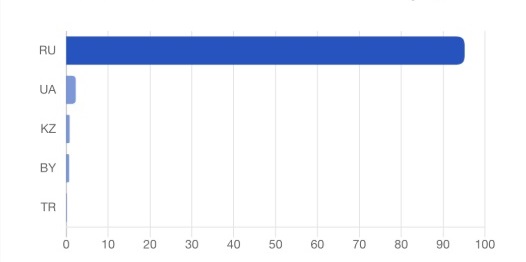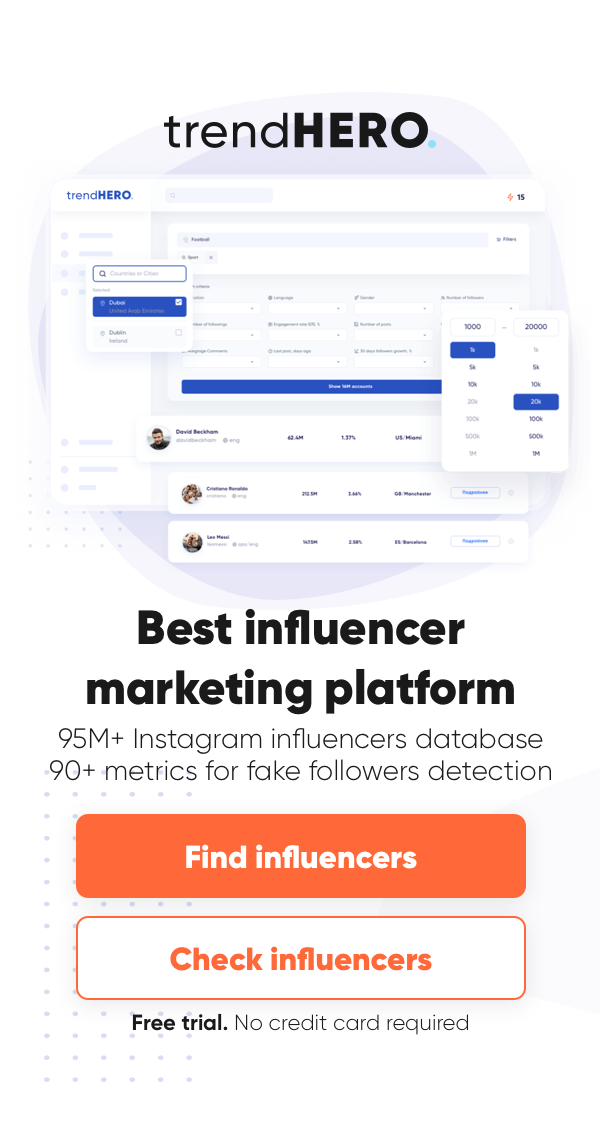- Home
- BLOG
- Influencers
- 11 Influencer Marketing Problems and Solutions
To say that the interest in social media marketing is growing from year to year is to state the obvious. People spend over three hours on their smartphones on a daily basis. Most of that time is devoted to social media. No wonder that in this context, influencers become the channel for marketing that has the closest connection to customers. Unfortunately, this does not eliminate the problems that hinder the natural growth of influencer marketing.
These problems are common for all marketers willing to adapt to the new rules of the online advertising market. “Traditional” advertising can’t compete with authentic communication with the audience any longer. This is the environment marketers have to learn to navigate today.
While digital advertising still works for certain marketing purposes, it suffers by comparison to influencer marketing. People tend to distrust “traditional” methods of advertising and actively use ad blockers. As a result, potential customers just never get to see 20% of all online ads. At the same time, social media users are a great deal less dismissive of the opinions offered by influential content creators.
Common pitfalls of influencer marketing
- It’s difficult to measure and improve ROI.
- No guarantee of marketing campaign success.
- It’s difficult to find suitable content creators with an engaged audience.
- Weak accountability and compliance of content creators.
- The cost of product placement increases while its effectiveness decreases.
- Declining confidence in content creators due to disingenuous product advertising.
- Lack of understanding of how to promote a product using influencer partnerships.
- Influencers are mostly chasing metrics growth and earnings.
- Risk of reputation damage due to the actions of content creators.
- Wrong choice of the target audience.
- Discrepancy between the number of followers and actual influence.
Influencer marketing is all about human interaction. It’s quite hard to predict how your relationships with people will work out. And it’s just as hard to make your influencer marketing strategy work strictly according to the script. Who would you like to partner with, a celeb with millions of followers or a niche blogger? The correct answer doesn’t always lie on the surface. It’s difficult to predict how your interaction with content creators will go. But it doesn’t mean that there’s nothing you can do about it.
1. It’s difficult to measure and improve ROI
However surprising it may sound, over one-third of all marketers can’t assess the effectiveness of influencer marketing for their campaign. To achieve the desired ROI, brands first of all need to clearly understand what influencer marketing is all about.
Promoting products with the help of content creators is one of the most popular ways to address potential customers directly. Many marketing experts believe that it’s a great way to increase reach and engagement rates. But while it’s fairly easy to evaluate the effectiveness of digital advertising, influencer marketing ROI is hard to assess using any direct methods.
According to Rakuten Advertising survey, nearly 40% of marketers are not sure about the effectiveness of their campaigns. At the same time, almost 90% of them find it difficult to understand how exactly influencers calculate their compensation for a sponsored post or entire marketing campaign.
Solution: assess the effectiveness of your marketing campaign

First of all, set concrete goals. What is it you want from this particular campaign? Raise brand awareness? Increase the level of trust for your brand? Increase sales? Increase clicks? Get some feedback on your products? Win over new target audiences?
Once that’s cleared up, think your marketing strategy through, write a detailed brief and choose the suitable content creators. If you really want to make it easier for you, go to one of the many influencer marketplaces and marketing platforms. That’s where you can find all the information you need on sponsored content they previously created and on your campaign’s prospective reach.
When choosing creators, pay close attention to their metrics during previous campaigns they participated in. Or just ask them to provide you with comprehensive information on these metrics.
Sure, at first it might seem that ROI in influencer marketing is hazy at best. But you can actually analyze it by paying attention to the following criteria:
- audience coverage;
- engagement rate;
- interactions;
- number of subscribers;
- website traffic;
- number of app downloads;
- increased number of subscribers on your official website;
- increase in sales.
According to the Linqia report, 81% focus their attention above all on audience engagement rates. That is, they attach the greatest importance to the number of users who viewed the sponsored post, the number of likes, comments, and shares. When using the methods of influencer marketing, they stake on brand awareness and increasing brand loyalty. The thing is the main point of this kind of product promotion is to gain customers’ trust and make them your brand supporters. That’s why it’s so important to find creators who will become your brand advocates.
There are a few methods to track ROI. You can use influencer marketing platforms or software that allows analyzing marketing activity:
- Analyze the increase in subscribers on your brand’s official website and social media profiles. It’s fairly easy to do: just monitor any changes during a week after the influencers you partnered with publish their content.
- One of the easiest ways to track the number of clickthroughs is by using UTM tags. An influencer adds a tag like this to their posts mentioning your products. You can also utilize promo codes with discounts for your products and see how many sales you get as a result.
- In case you want to learn how much did brand awareness and engagement rate grew, analyze content creators’ posts. The number of likes, comments, and shares will give you a hint about how effective these posts are.
2. No guarantee of marketing campaign success
As I already mentioned, it’s hard to predict and plan how exactly your collaboration with influencers will go. More often than not marketers can’t control content creators completely. Some influencers might leave a negative review of a product after trying it. Some might just produce subpar content, which is probably even worse. Unfortunately, this is an issue all brands deal with, however large.
On the other hand, when a marketer places strict requirements on the sponsored content, it doesn’t do anyone any favors. Inauthentic, pushy content won’t earn any trust from potential customers. As a result, a content creator has a disappointed audience and a marketer has zero advantage for their marketing campaign.
It’s important to understand how regular ads are different from a content creator’s recommendations. Influencers produce quality content that’s generally liked by their audience. They publish what they are passionate about, and this is exactly what makes influencer marketing so effective.
Solution: use a personal approach and introduce a uniform system for all procedures within the framework of your influencer marketing campaign

- Make sure you have a team assigned specifically to this marketing campaign, including all communications with content creators.
- Make sure you have all documentation templates ready. Briefs, content plans, contracts, statements of work – all of these can save you and your partners a lot of time.
- Speaking of briefs, make sure you draw them up correctly. Content creators must have a clear idea of what kind of requirements and suggestions you’ve got. For many influencers, it’s a job that takes much time and resources. So they won’t be happy to know they have to make multiple corrections after the content is created and ready to go live.
- There is plenty of online influencer marketing platforms that will let you monitor your campaign’s progress and assess its results. Don’t miss the opportunity to use one of them, depending on what kind of social platform you use. They are a great time-saver.
- Do everything it takes to ensure the consistency of communication between you/your team and a content creator. No questions must go unanswered, no issues undiscussed.
- Make sure you keep all logs, reports, documents, and notes on your collaboration with every content creator.
3. It’s difficult to find suitable content creators with an engaged audience
There is no lack of influencers on any social platform. There are content creators for every niche in existence. So even if you want to market a very narrow niche product, there are probably influencers who work in the same niche.
The problem is even with this wealth of choice, choosing the content creator that will suit your marketing campaign and your brand mission perfectly might be quite a challenge.
The thing is finding the content creator that operates within the same niche is only half the task. Once you find them and before starting a collaboration, you have to evaluate just how effective they are going to be for your campaign. To do this, you’ll need to take time to assess a few criteria, such as:
- number of subscribers;
- engagement rate;
- quality of content;
- posting frequency, including sponsored content;
- consistency and relevance of content.
Solution: use multiple tools and methods of assessing a content creator’s suitability and authenticity

First of all, there is something you have to keep in mind when contacting a content creator:
- There must be a strong correlation between your brand and the general theme san aesthetic of an influencer’s blog/channel.
- Marketing will only be effective if a content creator tried your product;
- Influencers prefer long-term partnerships;
- Creative freedom is critical for your campaign’s success.
After you’ve got that covered, here’s what you might want to do to assess a content creator’s suitability:
1. Start tracking metrics that show the true effectiveness of an influencer’s content.
One of the most important metrics is user engagement. You can, for example, monitor the number of views during a certain period of time. However, the fact that users view posts doesn’t necessarily mean that they interact with it in any way. You need to look at likes, comments, and shares. Each of them is a form of engagement. What’s more, it’s always easy to access these stats and they can become a very useful tool for assessing influencers.
By comparing the number of all interactions with the posted content to the general number of views you calculate the engagement rate. It lets you see how well this particular blogger interacts with its audience.
2. Less is more.
Celebrities and macro-influencers with millions of subscribers make up less than 1% of all influencers. While there’s a certain flair to the celebrity status, content creators with small followings are more relatable. They look much more like your regular customer and because of this, their subscribers trust them. Sure, there is a huge difference between a multi-million following and a subscriber base of a few dozen thousand. Buty in fact, a small audience is also a more engaged and more genuine audience.
There are numbers to prove that. The average engagement rate for celebrities and macro-influencers is 1-3%. For micro- and nano-influencers it’s 5-7%. So you can actually attract more customers with several sponsored posts in a micro-blog than a single post in a celeb blog. Leave alone the fact that promoting products with celebrities will cost a great deal more.
3. Use influencer marketing platforms.
Again, these online platforms are incredibly useful. They often offer a variety of tools for working with social media and help to find the right content creators. They provide content reviews and assessments of audiences and their activity. Finally, they allow tracking the effectiveness of posted content.
4. Weak accountability and compliance of influencers
Another important issue is the challenge of controlling content creators to make sure they comply with their commitments. Unfortunately, it’s not too uncommon that an influencer fails to meet a marketer’s requirements, which significantly decreases the effectiveness of the collaboration. As a result, marketers get disinterested in working with content creators in general.
Too many bloggers think that being an influencer is a glamorous and prestigious thing to do. Sadly, not many of them understand that it takes a lot of effort, commitment, and integrity.
This weak accountability and lack of compliance occur in pretty much any niche of the market. Even despite hefty fees and 100% advance payments, some content creators can go off the radar or just publish subpar content.
Many marketers believe that this lack of accountability is due to the freedom offered by the format of their interaction with their audiences. Some creators still struggle to understand the difference between “sharing ideas” and “recommending a product”. Needless to say, all this makes your marketing budget go down the drain.
Solution: establish a clear framework for your cooperation

1. Provide clear instructions
The first and the most important thing you should do before launching your influencer marketing campaign is to create clear instructions for content creators. Being on the same page is critically important.
It’s also important to have a clear understanding of what kind of bloggers you are looking for right from the start. Trying to change the conditions of your collaboration after the campaign is launched is a bad idea. Before signing a contract with a content creator, make sure they understand the nitty-gritty of your campaign. Make them see the full picture: campaign goals, what kind of visual content you want to see, etc. And make them familiar with the smaller details: hashtags and keywords they need to use, links to your website and/or social media profiles, etc.
2. Choose the correct scale
Instagram, one of the most popular social platforms, has over a billion active users. To achieve meaningful results, engage multiple influencers. Dozens, if you have to. Frequent short-term marketing campaigns that engage a few influencers won’t help you get to the top.
Depending on your goals and the type of product you want to promote, you might want to focus on:
- quantity: if your product is intended for the mass consumer, you should work with content creators of different age/gender/race to maximize your reach and increase sales;
- quality: in case what you have is a niche product, choose bloggers who have credibility and trustworthy reputation to make sure you attract your target audience.
3. Draw up a contract
When there are two parties heavily invested in collaboration, some legal basis will never hurt. Influencer agreements are critical for protecting the interests of both marketers and content creators, especially if a long-term campaign is what you have in mind.
A contract gives a clear idea of what you want from a blogger, how you want it done, and sets clear timeframes. On the other hand, it ensures that a content creator receives their payment in time and in full.
4. Pay them fairly
Some brands believe that content creators will promote their products in exchange for the said products or certain services. While this format of cooperation isn’t exactly uncommon, it might not work in the long run.
Influencers (provided they take it seriously) put a lot of time and effort in creating high-quality content. To ensure the best results, you’ll have to pay for their services fairly.
5. Make sure your cooperation is as transparent as possible
Each post you sponsored must be disclosed as such. Doing otherwise isn’t just illegal because it violates FTC rules. It also undermines the trust users have for content creators, and their distrust might hurt your marketing campaign badly.
It might sound strange, but using the #sponsored hashtag doesn’t do any damage to a content creator’s reputation. Their followers can see they are honest about their sponsorships and it makes them trust influencers even more.
5. The cost of product placement increases while its effectiveness decreases
Let’s be real: no one is thrilled to see ads. And trust me, people are even less thrilled when these ads are as in-your-face as possible. Unfortunately, content creators sometimes choose not to disclose sponsored content. Sure, this is illegal and promises all kinds of troubles but there’s also the fact that they don’t fool anyone.
People can easily recognize non-native ads, even when there are no FTC compliance hashtags. As a result, you have distrusting, disinterested followers and that’s what makes the effectiveness of your campaign plummet dramatically.
The usual culprits are celebrities and macro-influencers with multimillion followings. More often than not, they use pre-written content. And when there’s no such thing, they don’t bother writing theirs and mostly just post a link to a sponsor’s website or social media profile. At the same time, the cost of sponsored content on such influencer pages is extremely high. As you understand, not the best value for your money.
Solution: make sure that a content creator can offer native content seamlessly integrated into the general theme and aesthetic of the blog-social media profile

First of all, study all sponsored content on an influencer’s page. How genuine and authentic does it look? What kind of response does it get in the comment section? If you don’t see any blatant advertising, there are a few reasons for that:
- sponsored content is so authentic that they look like genuine recommendations;
- the content creator refuses to post sponsored content. It’s not a bad thing per se, maybe they just want to recommend only what they personally tried and liked. This kind of recommendation might elicit a very positive response;
- marketers prefer not to promote their products with this influencer’s help. This might be a red flag;
- a content creator removes sponsored posts after a while. Pay special attention to this factor and make sure you discuss it with the blogger, in case it’s important to you.
Again, read the comments under every sponsored post. Does it look like this blogger’s audience is ready to positively accept this type of content? Note the way they react.
And there’s one more important thing to remember. If you want the sponsored content to look native, let content creators generate it independently. Forget about pre-generated visual content and texts: unique content is what you need. When an influencer recommends your product, their users must see it as their genuine choice. Then and only then will they believe them.
6. Declining confidence in content creators due to disingenuous advertising
Brands and followers alike feel like their trust in influencers is waning. Why? Because influencers just don’t use the products they are trying to promote. Many marketers admit that a great number of content creators they communicated and worked with never asked any questions. Apparently, they were not interested in the brand mission and identity. They didn’t want to know what their target audience is. In fact, it didn’t matter to them which product to promote.
This disingenuous attitude is what causes influencer fatigue. Followers go increasingly sick and tired of drab content that’s being force-fed to them under the pretense of sincere interest in the product.
1. The amount of sponsored content is getting overwhelming.
Do you feel like there’s too much advertising on social media? You are not wrong. According to Klear, influencer marketing grew by nearly 40% in 2018, and this number still keeps growing. Sponsored content is everywhere you look. No wonder this oversaturation of ads makes users grow numb to this type of content.
2. Consumers get increasingly distrustful of influencers.
According to Carmichael Lynch survey, 15% of content creators admitted that they don’t like the products they are promoting. This is quite a matter of concern, considering that influencer recommendations are supposed to have the credibility traditional advertising lacks.
So it’s hardly surprising that consumers are less and less inclined to give bloggers the benefit of the doubt. And marketing your products with content creators who could care less about them will make your campaign fall apart.
3. Sponsored content looks generic and drab.
More often than not, content creators remember to feature a product in their content and completely forget about any originality. So what you mostly see are smiling faces and various products held up so you could see the logos. As a Bazaarvoice survey shows, almost 50% of consumers are tired of this repetitiveness.
4. Decrease in engagement rates for sponsored posts.
Engagement rates for sponsored posts dropped dramatically. In the first quarter of 2019, the average estimated engagement rates plummeted to 2.4% compared to 4% in 2016. This happens on all platforms, in all niches.
Solution: keep up with the changing trends by utilizing cooperation with content creators correctly

1. Stop thinking about content creators as tools for promoting your products and start treating them as partners.
2. Take time to find content creators that truly stand out and generate original content. For example, someone like Instagrammer paigearminta. She always adds videos to her photos to show how these photos were created.
3. Utilize micro- and nano-influencers. Content creators with followings of a few thousand subscribers and less have loyal audiences. As a result, their engagement rates are much higher than those of influencers with huge followings.
4. Make sure that content creators you partner with know your brand, its mission, identity, and goals. They have to be genuinely interested in the product you are marketing. They have to sincerely like it. This will generate the level of trust that will boost your marketing campaign big time.
5. Adjust your marketing strategy. The authenticity of the content should be your priority.
6. Establish a trusting connection with content creators who use your products. They can become promising partners who will offer a genuine opinion on your products.
7. Lack of understanding of how to promote a product using influencer partnerships
Some brands still struggle to understand the specificity of working with content creators. The main issues are the lack of understanding of how this format even works and choosing all the wrong KPIs. Every marketer wants sales, raised awareness, good audience coverage, sometimes all of that at once. Unfortunately, not every marketer understands how exactly you get all that and what kind of methods they have to utilize to reach the desired goals.
What’s more, many marketers are not sure how to use content creators for promoting their products. They often impose stringent frameworks that seriously limit the creative freedom of bloggers.
The most common mistakes marketers make usually are:
1. Choosing the first content creator available.
Opting for just any blogger that seems to operate in a similar niche is not a good idea but marketers seem to make this mistake quite often.
2. Cold calling.
Contacting bloggers you have never spoken to before and know nothing about doesn’t always work as well as you hope it would. Content creators get contacted by people they know nothing about every single day and in most cases, they leave these messages unanswered.
3. Being cheap.
If you think that bloggers will happily jump at the opportunity to promote your product for the words of gratitude or promise of exposure, think again. In order to have a meaningful partnership, you will have to pay them.
4. Underestimating the power of communication.
If you don’t think that communicating with a content creator is necessary, be prepared for all kinds of frustrating misunderstandings.
5. Controlling every step they make.
Sure, every marketer wants everything to be perfect. Unfortunately, there is no such thing as perfect. If you don’t give them enough creative freedom, your marketing campaign will suffer for it.
6. Chasing vanity metrics.
Such as the number of followers you got during the campaign. While it might be great to get new followers, this doesn’t really do anything for you.
Solution: get your priorities straight

- If you are going to partner with content creators, make sure they are perfectly suitable for your brand. Learn what they think both about your brand and your product, make sure they share your values. Do your research because otherwise, you might face the risk of damaging your brand reputation.
- When you have to contact someone you have never spoken to before and establish a connection, be as clear, concise, and to the point as possible. Don’t send identical generic messages to all content creators. This is where a personal touch can go a long way. Again, this takes some research. Take time to learn more about a blogger you plan to partner with before you contact them.
- Barter collaborations happen. However, it would be wrong to think that every blogger you contact will be happy to take your product and recommend it to their followers. There is a reason why brands decide to increase their marketing budgets.
- Constant communication with content creators is extremely important. There must be no misunderstandings or doubts as to your desires and preferences concerning sponsored content. Bloggers must be able to reach out to you with any questions and suggestions, any time. Every detail must be made clear, discussed, and compromised on, if necessary.
- Give a content creator some space for creativity. If all your collaboration comes to is a blogger doing your bidding, the sponsored content will come across as forced and lifeless. Trust me, this always shows, especially if the usual way they communicate with their audience is casual and easy. Let them help you market your product in their own unique way and style.
- If you want to pay close attention to metrics, track those that really make a difference. There might be lots of likes, there might be new followers coming but that doesn’t matter if they don’t follow the links and buy your products.
8. Influencers are mostly chasing metrics growth and earnings
Marketers are not the only ones who might show a certain lack of understanding of what this is all about. Many content creators choose to track only their basic metrics like the number of subscribers/followers and views. They are often ready to generate any kind of content that will improve their metrics. Unfortunately, this chase for meaningless metrics often motivates them to create provocative and controversial content that might hurt your brand reputation. Besides, while this can make certain metrics grow in the short term, they will drop in the long term.
Sometimes bloggers pursuing personal financial gain post content sponsored by competitors. In this case, posts sponsored by rival brands might go one after another.
Influencer fees often depend on the number of their subscribers, so it’s not really surprising they would try to increase that number in any way possible. Unfortunately, the possible ways often include getting fake followers who will not be interested in your product and won’t buy it.
Solution: look for artificially inflated metrics

The good news is it’s not that hard to learn whether a content creator has the deadweight of many fake followers. All you need is attention.
- Firstly, compare the number of subscribers and the number of likes. The latter value should be at least as high as 2-3% of the general number of followers. The smaller the following, the higher the engagement rate. And keep in mind that it’s likely that all bloggers with large followings also have a large number of fake subscribers.
- Read the comments. Most of them must be relevant and substantial and address the content creator directly. If all you see is emojis and single-word comments like “Cool!” or “Great!”, you are looking at the fake following.
- It’s worth noting that a large number of followers from all over the world who hardly have any following of their own is are a typical sign showing that a blogger has an army of bots.
- There are many specialized services that can help you with tracking any suspicious activity on influencer accounts. Whenever you see a sharp spike in the number of followers, it’s likely you are dealing with the purchase of fake followers.
- Include provisions for accountability for any dubious actions in your contract with a content creator.
9. Risk of reputation damage due to the actions of content creators
Collaboration with content creators and bloggers can and will be effective and bring positive results. Unfortunately, there’s a flip side to this coin. Sometimes your partners might engage in actions that directly contradict your brand principles and can do substantial damage to its reputation. After all, when you partner with a content creator, their audience sees you as a tandem.
The non-disclosure of sponsored content is one of the major issues. FTC rules state it in no uncertain terms that each sponsored post must be clearly disclosed as such. And yet both brands and content creators often choose to ignore these rules and as a result, put themselves at risk of legal sanctions.
The thing is many content creators believe that such disclosures will undermine the trust of their followers. Interestingly enough, that’s not the case. People tend to see these disclosures as a sign of honesty and integrity.
Solution: protect your brand safety
1. Choose content creators to partner with carefully.
There is no one who understands your brand values, principles, and goals as well as yourself. So why delegating the important task of selecting the right influencer to any third parties? Do thorough research of a content creator’s background in terms of collaborations with other brands, their reputation, the way they treat their audience.
2. Look for reputable bloggers with a positive history of brand collaborations.
Do they share your brand values? How authentic are they? Do they offer complete transparency when it comes to sponsored content? Do they have any experience in successfully collaborating with similar brands? Make sure you find answers to all of these questions when considering a partnership with a content creator.
3. Take an active part in the content generation process.
As I mentioned earlier, giving content creators some space for creativity is important. This doesn’t mean, however, that you should completely withdraw from the content creation process. Make sure you discuss the format and character of content with influencers. Carefully review the content and offer your suggestions. A detailed content plan and schedule might help you avoid many issues.
4. Have a detailed contract.
Again, contracts protect the interests of both parties. Make sure all your requirements and expectations are set forth in the contract in great detail. Besides, a contract allows ending a collaboration in case of any violation.
5. Ensure compliance with FTC rules.
All sponsored content must be disclosed as such, with no exceptions. Make sure that your partner understands that, as well as the consequences of non-compliance.
6. Utilize influencer marketing agencies.
Working with an agency can make your life as a marketer much easier. They will offer access to reputable content creators, help you with your marketing campaigns, and solve issues that might arise along the way.
10. Wrong choice of the target audience
Let’s say you’ve got a small company that operates locally. If you partner with an influencer whose followers are predominantly from other countries, your product will be absolutely irrelevant for them. As a result, your marketing campaign will be pointless.
Or here’s another example: your brand offers expensive luxury products but the audience of the content creator you chose to partner with is mostly kids and teenagers. Not that they wouldn’t want to treat themselves to your expensive products but they will hardly be able to buy them.
And another one: the majority of your customers are middle-aged men but an influencer’s followers are young ladies.
All this might happen in case you don’t do thorough research before partnering with a blogger and aren’t sure what their target audience is. Or if you don’t know what your brand’s target audience is.
Solution: pay attention to demographic metrics

Gender, location, age – these are the most important metrics you will have to know to make sure you are marketing to the correct target audience.
If you organize and launch your marketing campaign manually, make sure that your TA is also the TA your content creators cater to. Don’t hesitate to ask them for detailed statistics on their account. If a content creator is honest, confident, and has nothing to hide, they will most likely gladly provide you with all necessary stats. If they refuse… well, that’s a major red flag for you.
Detailed demographic stats is also something you can get on influencer marketing platforms like trendHERO. Apart from the incredibly convenient and time-saving automated search they also offer blogger lists sorted into categories based on niches and topics. And that’s something you need to take into account as well.
11. Discrepancy between the number of followers and actual influence
It’s important to understand the difference between people who have a blog with a large number of followers and influencers. There are many people including celebrities who have substantial followings on social media. However, all these followers are much more interested in a blogger’s lifestyle and pretty visual content than product recommendations and purchasing.
It’s not always easy to notice the difference between the two. It’s quite likely that an account with millions of subscribers has a certain influence over them, in some ways.
Being popular doesn’t automatically mean influence. When it comes to true influence, vanity metrics like a number of subscribers or likes don’t matter much. What do matters is honesty, authenticity, quality of content, passion, the way they interact with their following.
Finding content creators with real influence is one of the most difficult tasks of influencer marketing today. It’s critical to make sure that a blogger you plan to work with doesn’t just have a large following but has a high level of credibility.
Solution: carefully assess the most important criteria of influence

1. Level of audience engagement.
Take note of how many followers like share, and discuss an influencer’s content in the comments. A high level of engagement means that followers find this content interesting.
That being said, comparing the number of subscribers to the level of engagement makes a lot of sense. If the former number is way too low compared to the latter, it most likely means many fake followers or the audience’s low interest in the posted content.
2. Authenticity.
Authenticity is a passion for the chosen niche, honest opinions offered to subscribers, and active interaction with them on a personal level. Followers are normally hard to fool. No matter how pretty your photos are, they will know if you don’t care about what you say and recommend. Similarly, they will always be drawn to honest content and sincerity. This is what makes them trust content creators and hold by what they say.
Make sure that there are all the signs that show that level of trust.
3. Level of authority.
A true influencer is someone who motivates their followers to think, to act, to share their ideas and opinions. That is the kind of content creator you want to partner with.
This level of influence can’t be reached without original, unique, high-quality content. Check their social media profiles to get an idea of how original and exclusive their content is.
4. Similar niche and values.
A content creator might have all of the above but if they operate in a different niche that doesn’t correspond with your brand and products in any way, there’s no point in collaboration. Moreover, they should stick to no more than one or two niches. Influencers who claim they cater to everyone cater to no one.
5. Consistent posting.
The level of a content creator activity on social media matters a great deal. Make sure they are fairly active and don’t make their followers wait for weeks for updates. At the same time, it probably wouldn’t be a great idea to partner with a content creator who spams dozens of posts a day.
Conclusion
More and more brands declare that they want to work with influencers who really like their products and services. Who buy and use these products and services on a regular basis. One of the major issues of the influencer marketing scene today is the need to move from quantity to quality. In this context, quality means the high level of audience engagement in all content generated by bloggers, whether it’s sponsored or not. This high level of engagement is impossible without the following important criteria:
The authenticity of sponsored content generated by an influencer who is both a consumer and an ambassador;
Working in accordance with the principle that influencer marketing is not advertising but a recommendation.
It’s authenticity and sincerity that made so many successful marketing campaigns famous. After all, everyone tends to listen to recommendations rather than to what they say in ads.
Influencer marketing isn’t as complex as you might think. What you need is to keep up with the changing trends. There is always a solution to every issue.
We also recommend to read
Instagram Engagement Rate Calculator For Free
Check any influencer's Engagement rate and analyze his or her followers growth history
Other free tools: Follower Count History, Instagram Follower Count, CPM Calculator






